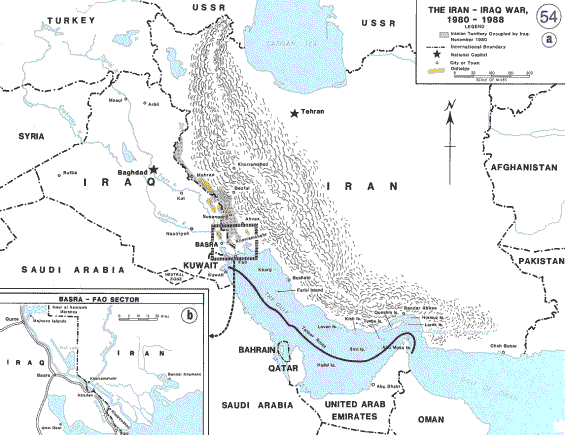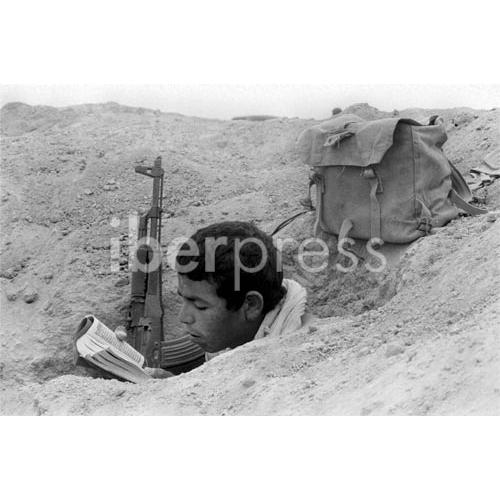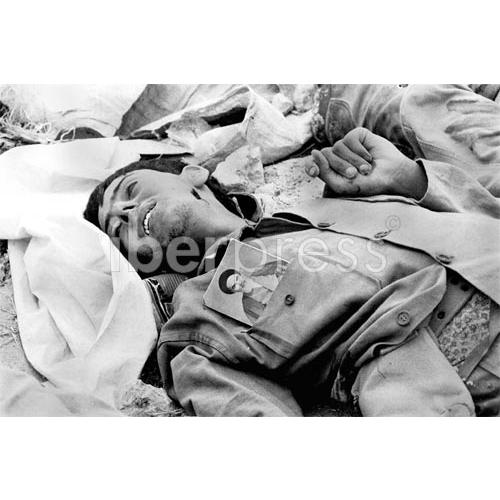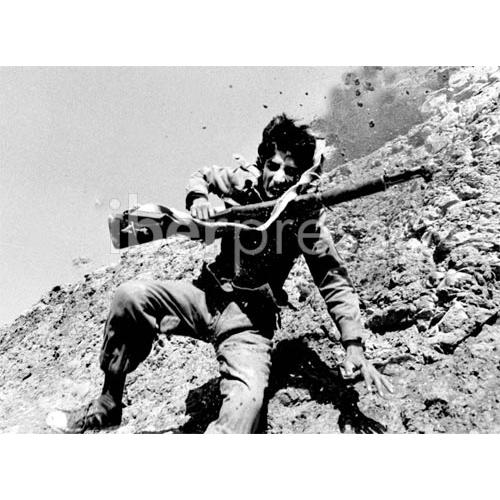 |  |  |
| Romanian Army in the Second World War · Forum Guidelines |
 Help Help
 Search Search
 Members Members
 Calendar Calendar
|
| Welcome Guest ( Log In | Register ) | Resend Validation Email |
| Pages: (3) [1] 2 3 ( Go to first unread post ) |    |
| Dan Po |
Posted: January 23, 2005 10:46 pm
|
|
Sergent major Group: Members Posts: 208 Member No.: 226 Joined: February 23, 2004 |
Lets talk about this forgotten war:
Relations with Iran grew increasingly strained after the shah was overthrown in 1979. Iraq recognized Iran's new Shi'ite Islamic government, but the Iranian leaders would have nothing to do with the Ba'th regime, which they denounced as secular. Ayatollah Ruhollah Khomeini, the spiritual leader of the Iranian revolution, proclaimed his policy of "exporting the revolution," and Iraq was high on the list of countries whose governments were to be overthrown and replaced by a replica of the Islamic regime in Iran. In addition, Iran still occupied three small pieces of territory along the Iran-Iraq border that were supposed to be returned to Iraq under the treaty of 1975. In 1979 and 1980, border clashes occurred frequently. Saddam Hussein announced on Sept. 17, 1980, that he was abrogating the 1975 agreements because they had been violated by Iran. On Sept. 21-22, 1980, Iraqi forces invaded Iran; at the same time, Iraq bombed Iranian air bases and other strategic targets. On September 28 the UN Security Council called for a cease-fire and appealed to Iran and Iraq to "settle their dispute by peaceful means." Saddam Hussein replied, saying that Iraq would accept a cease-fire provided Iran also did so. Iran's response, however, was negative. Further attempts at mediation in 1980 and 1981 also were rejected by Iran. The war thus continued and in succeeding years was extended to the gulf area, leading to foreign intervention. It has been aptly called the Gulf War. The Iraqi advance into Iran was stopped in November 1980. There followed a stalemate that continued until September 1981, when Iran began a series of successful offensives. By May 1982 the Iraqis had been driven from most of the captured territory. Iranian forces began to penetrate into Basra province. During 1983-86 they occupied Majnun Island, threatened the city of Basra, and occupied the Fao peninsula. In the northeastern provinces Iranian forces, in cooperation with Iraqi Kurds, threatened the area from Kirkuk to the Turkish border and penetrated to the towns of Hajj 'Umran and Halabjah. They met with stiff resistance in the north, however. Using chemical weapons, Iraqi forces inflicted heavy casualties on the Kurds. The Iranian attacks on Basra were repulsed with heavy casualties on both sides. Iraq countered in the so-called tanker war by bombing Iranian oil terminals in the gulf, especially on Kharg Island. Iran's occupation of Majnun Island and the Fao peninsula and its threats to Basra continued to be of great concern to Iraq. In 1987 the military equation began to favour Iraq. Iraq obtained additional arms from France and the Soviet Union, which considerably improved its military position, and it improved relations with several Western countries, notably the United States; diplomatic relations with the United States had resumed in 1984. In 1987 the United States agreed to reflag 11 Kuwaiti tankers and escort them in international waters through the Strait of Hormuz. Britain and France also escorted tankers carrying their own flags. Despite the incident of the Stark, a U.S. destroyer that was inadvertently attacked by an Iraqi bomber on May 17, 1987, the United States supported Iraq, both diplomatically at the United Nations and militarily by providing information about Iranian military movements in the gulf area. In October 1987 and April 1988 U.S. forces attacked Iranian ships and oil platforms. On July 20, 1987, the UN Security Council unanimously passed Resolution 598, urging Iraq and Iran to accept a cease-fire, withdraw their forces to internationally recognized boundaries, and settle their frontier disputes by negotiations held under the auspices of the United Nations. Iraq agreed to abide by the terms of the resolution if Iran would also do so. Iran, however, neither accepted nor rejected the resolution but demanded amendments condemning Iraq as the aggressor in the war and calling on all foreign navies to leave the gulf. Military operations in the gulf resumed, and Iraq recaptured the Fao peninsula and the districts of Salamcha and Majnun. It became clear that Iran's military position in the gulf had become untenable. Fearing an internal uprising, Iranian leaders impressed on Khomeini the necessity of accepting the cease-fire in order to save the regime from collapse. Iran formally declared its acceptance of Resolution 598 on Aug. 20, 1988. When the foreign ministers of Iraq and Iran met for the first time in Geneva in August 1988 and later in 1989, there was no progress on how Resolution 598 was to be implemented. Iraq demanded the full exchange of prisoners as the first step, while Iran insisted that withdrawal of Iraqi forces from Iran should precede the exchange of prisoners. It was not until 1990 that both Iraq and Iran finally agreed to settle their differences on the basis of the 1975 agreement and carry out the terms of UN Resolution 598. This post has been edited by Dan Po on January 23, 2005 10:48 pm Attached Image  |
| Dan Po |
Posted: January 23, 2005 11:08 pm
|
|
Sergent major Group: Members Posts: 208 Member No.: 226 Joined: February 23, 2004 |
>>
Attached Image  |
| Dan Po |
Posted: January 23, 2005 11:11 pm
|
|
Sergent major Group: Members Posts: 208 Member No.: 226 Joined: February 23, 2004 |
>>
Attached Image  |
| Dan Po |
Posted: January 23, 2005 11:20 pm
|
|
Sergent major Group: Members Posts: 208 Member No.: 226 Joined: February 23, 2004 |
The Iran-Iraq War was one of the bloodiest wars in history. The statistic are not very accurate. Anyway, in april 1988 casualties were estimated at between 450.000 to 730.000 Iranians dead and 150.000 to 340.000 Iraquis.
http://www.fas.org/man/dod-101/ops/war/docs/3203/ |
| Victor |
Posted: January 24, 2005 07:27 am
|
|
Admin Group: Admin Posts: 4350 Member No.: 3 Joined: February 11, 2003 |
Sorry Dan. The photos without sources have been deleted.
|
| Dan Po |
Posted: January 24, 2005 08:58 am
|
|
Sergent major Group: Members Posts: 208 Member No.: 226 Joined: February 23, 2004 |
ok, no problem , i will try to find their source .... I understand your considerations.
This post has been edited by Dan Po on January 24, 2005 09:03 am Attached Image  |
| Chandernagore |
Posted: January 24, 2005 09:40 am
|
|
Locotenent colonel Group: Banned Posts: 818 Member No.: 106 Joined: September 22, 2003 |
This must be one of the most stupid wars in history. And the Irakis gave back the little they had won just before the first gulf war. Talk about mindless slaughter for peanuts
Some glorious experiments however. Like the large scale use of children to pay the butcher's bill This post has been edited by Chandernagore on January 24, 2005 09:43 am |
| Victor |
Posted: January 24, 2005 11:27 am
|
|
Admin Group: Admin Posts: 4350 Member No.: 3 Joined: February 11, 2003 |
Interesting. That soldier is equipped with an M1 rifle.
|
| Ruy Aballe |
Posted: January 24, 2005 12:03 pm
|
|
Plutonier major Group: Members Posts: 307 Member No.: 247 Joined: March 18, 2004 |
He must be an Iranian. The Shan government received lots of American M 1 rifles (and some Italian-manufactured ones too, made by Beretta) well before the Islamic overthrow of the monarchy.
I have seen also shots of Iranian soldiers with Czech-made Mausers, the regulation rifle of the Imperial Persian Army until the 50's. |
| Dan Po |
Posted: January 24, 2005 02:26 pm
|
|
Sergent major Group: Members Posts: 208 Member No.: 226 Joined: February 23, 2004 |
As I already say, all of those photos represents iranian soldiers. ...
I don t think that he s a regular soldier. Reasos: - the shoes - not army boots, just a pair of chinesse basketshoes .... - M1 rifle - not regular AK 47. In the shah s time, Iran was a good friend of US, they give to the imperial iranian air forces even F 14 Tomcat s. The Iranians use in this war human assault waves, in order to blow up the minefields etc .... in a pure kamikaze way. Here s a pic with this kind of iranian kamikaze: source: http://www.abadan.net/war/war1.jpg  This post has been edited by Victor on January 24, 2005 07:22 pm |
| Dan Po |
Posted: January 24, 2005 03:57 pm
|
|
Sergent major Group: Members Posts: 208 Member No.: 226 Joined: February 23, 2004 |
|
| Dan Po |
Posted: January 24, 2005 03:59 pm
|
|
Sergent major Group: Members Posts: 208 Member No.: 226 Joined: February 23, 2004 |
|
| Dan Po |
Posted: January 24, 2005 04:00 pm
|
|
Sergent major Group: Members Posts: 208 Member No.: 226 Joined: February 23, 2004 |
|
| Dan Po |
Posted: January 24, 2005 04:01 pm
|
|
Sergent major Group: Members Posts: 208 Member No.: 226 Joined: February 23, 2004 |
|
| Dan Po |
Posted: January 24, 2005 04:02 pm
|
|
Sergent major Group: Members Posts: 208 Member No.: 226 Joined: February 23, 2004 |
|
1 User(s) are reading this topic (1 Guests and 0 Anonymous Users)
0 Members:
 Pages: (3) [1] 2 3
Pages: (3) [1] 2 3 |
   |
[ Script Execution time: 0.0080 ] [ 14 queries used ] [ GZIP Enabled ]
Powered by Invision Power Board(U) v1.3.1 Final © 2003 IPS, Inc.











